Wayne R. Munns, Jr.
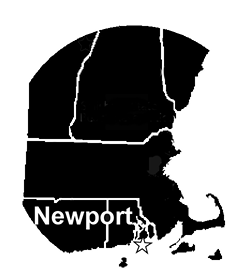 Rhode Island, that tiny state often confused with Massachusetts or New York by people outside of New England, has two well-known spring migration traps: Swan Point Cemetery in Providence (the mecca for spring migration advocates in Rhode Island), and Miantonomi Memorial Park in Newport. Miantonomi is much smaller—about 30 acres compared to Swan Point's 200 acres—yet it attracts a diversity of migrants and rarities on rival with or even surpassing Swan Point. Local birders proudly proclaim Miantonomi, or just "Mia" as we call it fondly, the "Swan Point of the South." And we do so with good reason.
Rhode Island, that tiny state often confused with Massachusetts or New York by people outside of New England, has two well-known spring migration traps: Swan Point Cemetery in Providence (the mecca for spring migration advocates in Rhode Island), and Miantonomi Memorial Park in Newport. Miantonomi is much smaller—about 30 acres compared to Swan Point's 200 acres—yet it attracts a diversity of migrants and rarities on rival with or even surpassing Swan Point. Local birders proudly proclaim Miantonomi, or just "Mia" as we call it fondly, the "Swan Point of the South." And we do so with good reason.
Readily accessible to the public, Miantonomi is a neighborhood park in southern Rhode Island, located on Aquidneck Island in Narragansett Bay. Bordered by Hillside Avenue to the east, Admiral Kalbfus Road to the south, Girard Avenue to the west, and Sunset Boulevard to the north, the park is easy to bird due to its convenient access, small size, and its pathways that traverse almost the entire park. One can cover all of Mia and bird well in two hours or less. But if bird activity is high, plan for three to four hours of intensive and exciting spring migration birding.
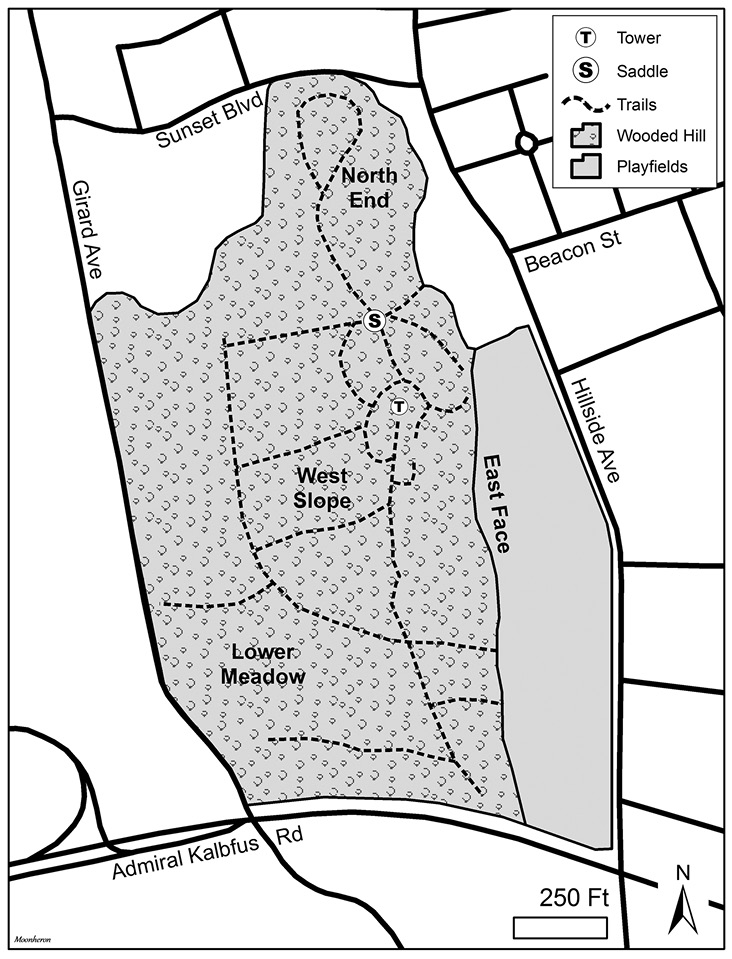
Figure 1. Map of Miantonomi Memorial Park.
Miantonomi has a long history. The park was originally called Tonomy Hill or Wanomitonomo Hill because of its most prominent feature—its wooded hill, the highest point in Newport County. Sachem (Chief) Miantonomi of the Narragansett people, for whom the park is named, ceded the hill to English colonists in 1637. The colonists used the hilltop as a lookout against foreign forces that might have eyes toward the New World.
In 1913, the famed landscape architect Frederick Law Olmsted, Jr. suggested that the city of Newport turn the area into a park, and on Armistice Day in 1923, the hill and surroundings were established as a war memorial and city park. Six years later, in 1929, a fieldstone tower approximately 80 feet tall was built atop Miantonomi Hill as a World War I memorial and to commemorate the 150th anniversary of the 1778 Battle of Rhode Island. (For history buffs, this is also known as the Battle of Quaker Hill or the Battle of Newport.) At Newport's highest point, the tower overlooks all of Newport and points beyond. Miantonomi Memorial Park was listed in the National Register of Historic Places in 1968. The Aquidneck Land Trust established a conservation easement on the site in 2005.
Originally Mia was designed as a city park with plantings of exotic tree species and comfortable park benches. Today the vegetation is an eclectic mix of older ornamental plantings and native trees. Oak, birch, pine, beech, and maple, along with various non-native species, provide a combination of trees similar to old New England cemeteries, yet with a big difference. Neither the original landscaping plan nor the health of the ornamentals have been maintained, leaving the park with a bit of a worn-down feeling. Old concrete park benches, crumbling with time, dot the landscape. Nevertheless, in the eyes of migrating birds, Miantonomi is a safe haven for spending a day or two on their journey northward.
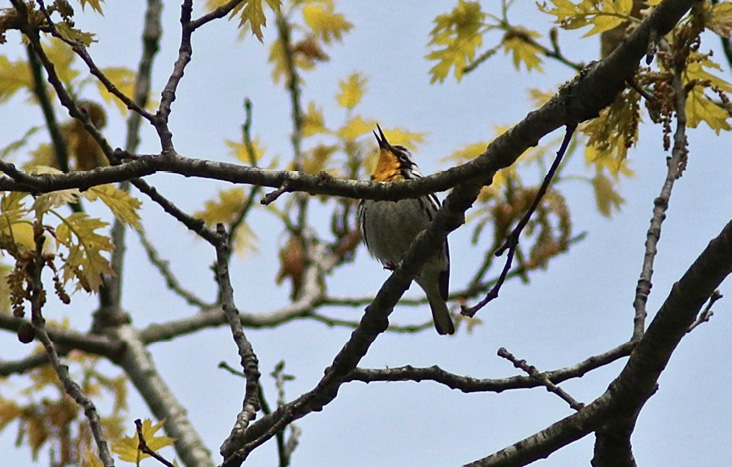
Yellow-throated Warbler. All photographs by Carlos Pedro.
Miantonomi also boasts interesting geology. The hill has unusual outcrops of puddingstone, a sedimentary conglomerate consisting of distinctly rounded stones and pebbles embedded in a finer-grained matrix. And it rises steeply to a height of 150 feet above the surrounding coastal plain, which is unusual for Aquidneck Island and anywhere else in southern Rhode Island. Maybe this is why Mia is such a spring migrant magnet.
The City of Newport began to upgrade portions of the park in 2017, creating new pathways that accommodate access by people with locomotor disabilities. It is reported that a meadow close to Girard Avenue on the west side of the park will be restored in 2018. Along with routine maintenance of the primary pathways, these efforts should enhance the value of Mia for birding and other uses. Miantonomi Memorial Park is open 24 hours a day, seven days a week. There is no entrance fee. All areas are easily accessible, but expect some steep uphill climbs.
Years ago, Mia had a deserved reputation for being an uncomfortable, and perhaps even dangerous, place to visit. Although the temporary tents of people lacking permanent homes can still be found in the deeper recesses of the park, local officials have done a great job of ensuring that the park is safe to visit. I feel completely comfortable visiting the park and try to do so nearly every morning during spring migration.
Birds (and Other Animals) of Miantonomi
Although no one knows why Miantonomi is such a great migrant trap, its wooded hill seems like an obvious safe haven and feeding stopover for Neotropical migrants arriving in southern New England after their long oceanic journeys. Mia meets the conditions that typically induce spring migrant fallouts; a green beacon on a hill surrounded by residential development most certainly is a great attractor to birds as they struggle to make landfall.
Miantonomi Memorial Park has no official bird list. I have recorded 132 species over the course of a decade of birding there. The eBird hotspot list <https://ebird.org/hotspot/L729779> for Mia coincidentally includes 132 species. I don't contribute often to eBird, and there are some differences between the two lists, so I estimate about 135 species for the park. Although this number might seem meager by some standards, in the context of the park's small size and lack of habitat variation, that's a pretty good count. Plus, you can find most of those 135 species at Mia during any given spring.
My personal list includes 32 species of warblers, with annual or near-annual sightings of sought-after migrants such as Cape May Warbler, Tennessee Warbler, Bay-breasted Warbler, Blackburnian Warbler, Worm-eating Warbler, Canada Warbler, and Wilson's Warbler. Some of the more uncommon warblers in Rhode Island can also be found here in certain years, such as Cerulean Warbler, Kentucky Warbler, Mourning Warbler, Prothonotary Warbler, and Yellow-throated Warbler (the latter two now almost annual at Mia). Yellow-rumped (Myrtle) Warbler, Blackpoll, American Redstart, and Black-and-white Warbler are by far the most common.
In addition to the southern warblers, the park attracts other species not normally seen in Rhode Island, such as Summer Tanager (now annual) and Blue Grosbeak. I've also seen a Mississippi Kite soaring over the park. As the climate continues to warm in southern New England and elsewhere, I think it's safe to expect to see other southern species at Mia in the years to come.
Rounding out the list of interesting species that just pass through on their way to breeding grounds are Least, Yellow-breasted, and Olive-sided flycatchers, Blue-headed, Warbling, and Yellow-throated vireos, Lincoln's and Clay-colored sparrows, and Indigo Bunting. I've even observed a Bobolink singing in the trees at the height of migration. Some of these species breed elsewhere in Rhode Island, others are just plain off track. With more summer visits to the park, birders might discover that some of the Rhode Island breeding birds, e.g., Yellow-throated Vireo, might breed at Mia.
Common and Red-throated loons, Common and Red-breasted mergansers, and other ducks, gulls, waterbirds, and shorebirds often fly over Mia as they move elsewhere from nearby Narragansett Bay. Raptors, including Red-tailed Hawk, Broad-winged Hawk, Sharp-shinned Hawk, and Cooper's Hawk, soar above the park.
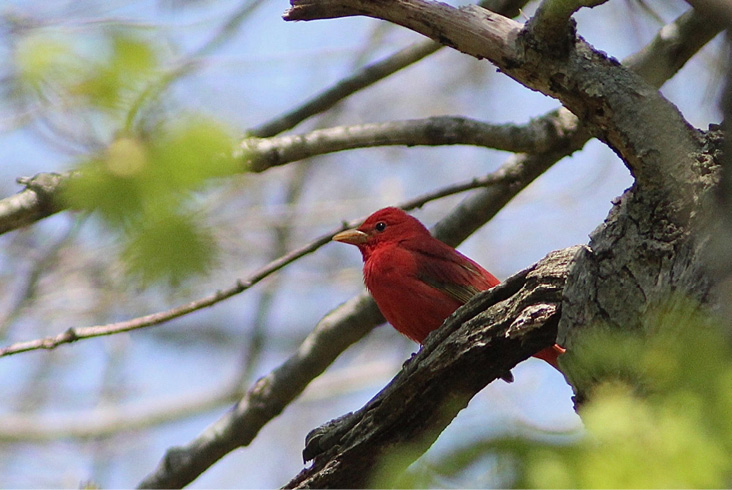
Summer Tanager
Species known or suspected to breed in the park include Ruby-throated Hummingbird, Eastern Phoebe, Great-crested Flycatcher, American Crow, Black-capped Chickadee, Tufted Titmouse, White-breasted Nuthatch, House and Carolina wrens (the latter another southern species moving north), Blue-gray Gnatcatcher, Rose-breasted Grosbeak, Baltimore and Orchard orioles, Red-eyed Vireo, American Crow, Gray Catbird, and in some years Cooper's Hawk. Yellow-billed and Black-billed cuckoos are observed often as well. Stay tuned for the results of the Rhode Island Atlas 2.0 <https://www.ribirdatlas.com/> that currently is underway and likely will change our understanding of nesting and wintering species in Miantonomi Park.
Other than humans, their dogs (usually leashed), eastern chipmunk, and the ubiquitous gray squirrel, Miantonomi has few large mammals. Virginia opposum, eastern cottontail rabbit, and an occasional raccoon round out its list of larger wildlife. Undoubtedly, the woods and fields host voles and mice, and various bats likely patrol for insects at night. I have encountered very few of these latter during my visits.
Birding Miantonomi
The birding at Mia is best in the spring: April, May, and early June. After the spring push, only a few species remain in the park to nest here. Summer through winter can be slow, with breeding species lingering into summer and woodpeckers like Yellow-bellied Sapsucker in fall and winter.
The park is divided into two main areas: a playground and a mowed, grassy, four-acre playfield on the eastern side, and the wooded hill to the west. Although isolated tall trees in the playground attract several species including warblers and vireos during migration, and Chipping Sparrows, American Goldfinches, and House Finches well into summer, this area usually deserves only a passing interest. However, Clay-colored Sparrows and Olive-sided Flycatchers have been seen in these trees on more than one occasion, so checking this area can be productive in spring. The open playfield usually attracts flocks of European Starlings, and Ring-billed and Herring gulls after heavy rains.
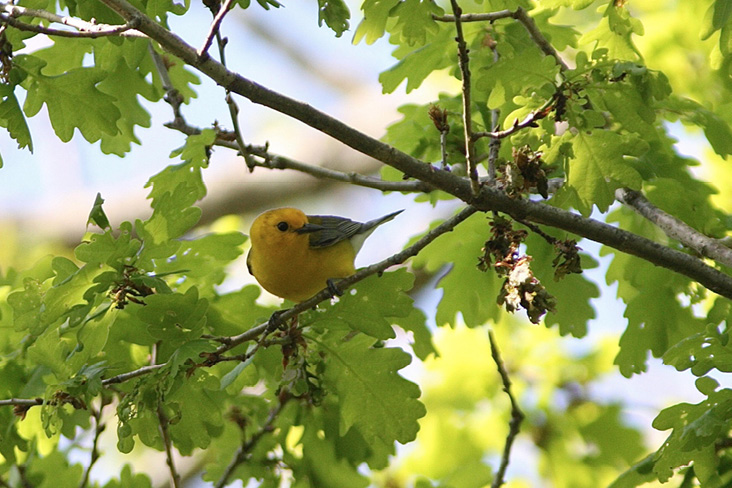
Prothonotary Warbler
The wooded hill is the feature that really attracts birds and birders alike. Unmarked but obvious pathways cut through the woods to allow access to almost all parts of the park. Local birders have given unofficial names to certain areas to help communicate more precisely the locations of good sightings. The Tower refers to the hilltop itself, with its prominent landmark used as a reference to all other locations. It is a somewhat open area with scattered ornamental trees that permits viewing of the upper third of the canopy of the forest below. This is a good place to look for flycatchers, warblers feeding in the ornamentals, almost anything in the surrounding canopy, and to scan the sky for raptors and passing waterbirds. Reach the Tower from the south using the main dirt road that begins near the disused restrooms at the south end of the playground, from the east by climbing the steep hill and old stone steps from an access point in the northwest corner of the playfield, from the west by two steep paths, and from the north by following the path leading south from the Saddle. (See Figure 1. Map of Miantonomi Park.)
Located just north of and below the Tower is the Saddle, so named because at its center the path rises to the north and south, and the intersecting path falls off to the east and west, thus emulating the curvature of a saddle. A couple of small depressions in this area can collect rainfall, which is attractive to migrants such as Mourning and Worm-eating warblers. This area in fully wooded with thick tangles of underbrush, and typically harbors the highest densities of migrants and residents alike. On fallout days, the cacophony of song here can be deafening, driving listeners like me back out into the open playfield to clear our ears! Adding to the challenge for listeners are lots of Gray Catbirds, Common Grackles, and House (or as I call them, French Fry) Sparrows.
To the north of the Saddle is, well, the North End. The path from the Saddle ends in a loop, the interior of which contains a small pool of displeasingly green water and often trash. Nevertheless, birds seem attracted to the water, as well as the brush surrounding it. Under certain conditions—clear weather with southerly winds—many migrants appear to stage in the North End as if getting ready to leave that night. That, however, is conjecture.
To the west of the Tower is the West Slope, with its wide main path running north/south and other paths climbing east up to the Saddle and Tower. This is a deeply wooded area that can be good for warblers, wrens, Rose-breasted Grosbeaks, and Scarlet and Summer tanagers. Other than American Robins, thrushes are not common at Miantonomi, but this wide path is one of the better places in the park to find (in descending order of abundance) Wood Thrush, Veery, Hermit Thrush, and rarely Swainson's Thrush out in the open. A good way to see thrushes here is to pause at the top or bottom of the straight main pathway and scan the open ground of the path. Sometimes, their singing gives them away before they are seen.
To the southwest of the West Slope is a linear open area called the Lower Meadow. You will see migrants and residents along its wooded edge, but the main reason for checking this area is to look for nesting Orchard Orioles, a southern species that is becoming increasingly common in Rhode Island.
The wide main path of the West Slope bends eastward at its southern end, ultimately intersecting with the main dirt road leading to the Tower. I use this path primarily as a conveyance between the wide main path of the West Slope and the Tower or playground.
Species along this path are similar to those found in the West Slope, and this area seems to be particularly attractive to Summer Tanagers.
Birding the East Face of the tree line along the eastern base of the hill, at the edge of the playfield, can be productive on sunny mornings as insects and their avian predators warm up. Birds can be low to the ground or high up in some of the larger oaks. I've seen Cape May Warbler here in scrub at about three feet off the ground and numbers of Black-throated Green Warbler equally low. You can reduce the strain of "warbler neck" from looking up at birds simply by taking a few steps back into the playfield to get a lower-angle view.
There is no well-established route to bird Mia; during spring migration the good birds can be anywhere. I usually begin by entering the woods on the pathway just east of the Tower, pausing at the Saddle to listen to where the action is, and then going from there. Otherwise, and unless my time is limited, I go up to the North End, walk along the West Slope, climb the hill to the Tower, and walk the East Face, all in just a little over an hour and a half. Of course, when things are really happening, I take time off from work to bird for three or four hours.
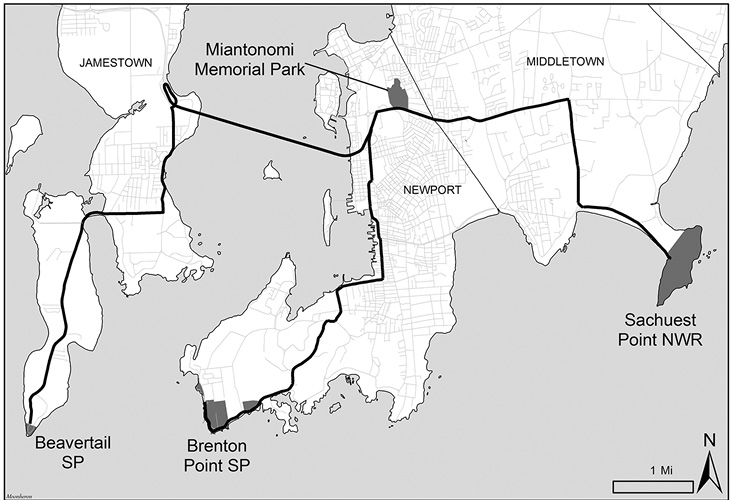
Figure 2. Birding Hot Spots in Southern Rhode Island.
Making a Day of It
Although spring migrants usually remain in Mia throughout the day, the birding slows noticeably after 10:00 am or so. Visitors who have traveled a distance might want to make a full day of their trip by birding other southern Rhode Island hot spots nearby. You can find seabirds, resident passerines, and spring and fall migrants at Sachuest Point National Wildlife Refuge and Brenton Point State Park, both located on the south end of Aquidneck Island, and Beavertail State Park at the south end of Jamestown. All of these places are within 10–20 minutes driving time of Miantonomi. (See Figure 2. Birding Hot Spots in Southern Rhode Island.)
The caveat during spring migration is that on a good birding day, you might end up spending your time at only one or two places, including Miantonomi Memorial Park. On a slow day, or during the other seasons, you might be able to hit all of these hot spots. Still, all are worth visiting if you journey this way.
Sachuest Point National Wildlife Refuge (Sachuest Point Road, Middletown, RI; 41°28'47.8"N, 71°14"37.0"W) is renowned as a migration stopover. Extensive coastal thickets provide a haven for birds coming north in spring and especially for birds preparing for their big flight in fall. Sachuest has been a reasonably reliable place to find Rhode Island rarities such as Yellow-breasted Chat and has hosted Western Kingbird and Bell's Vireo in the recent past. The refuge is particularly known for its wintering population of Harlequin Ducks (which has dwindled in recent years as the population shifts to Beavertail State Park), other sea ducks, Common and Red-throated loons, and Horned and Red-necked grebes, all easily found offshore with a spotting scope. During irruption years, Snowy Owls can be seen roosting during daylight hours on Island Rocks just offshore. Northern Harriers, and at times Short-eared Owls, and occasionally Barn Owls, hunt the hillside fields below the refuge headquarters in the late afternoon and early evening, frequently providing spectacular interspecies interactions. Shorebirds, gulls and terns, and dabbling ducks can be observed in the coastal marsh that has recently been restored. American Bitterns sometimes lurk in the grasses of the marsh. See <https://www.fws.gov/refuge/sachuest_point> for more information.
Brenton Point State Park (437 Ocean Avenue, Newport, RI; 41°27'4.3"N 71°21'6.3"W) at the southernmost point of Ocean Drive in Newport offers an open rocky coastline facing the Atlantic Ocean, a reforesting area that once housed a horse stable, and large expanses of mowed grass lawn. Like Sachuest Point National Wildlife Refuge, Brenton Point juts out into the Atlantic Ocean and is a first landfall for birds migrating north in spring. Shorebirds, including White-rumped Sandpiper, frequent the seaweed wracks and small sections of sandy beach during spring, summer, and fall, and gulls and terns can be seen fishing just offshore in summer. During fall migration, wooded areas and thickets can host numbers of warblers and vireos, and the park is gaining a reputation of being one of the better locations in southern Rhode Island for finding Connecticut Warbler and Philadelphia Vireo. Dickcissel is sometimes seen (more often heard) flying over the grassy lawns and thickets during fall. In fall and winter, Common Eider, all three scoters, and other waterfowl can be seen along the coastline, although they are not as plentiful as they are at Sachuest or Beavertail State Park. King Eider has been observed in recent years. Horned Lark and Snow Bunting flocks can be found on Brenton Point's lawns during late fall and winter. See <http://riparks.com/Locations/LocationBrentonPoint.html> for more information.
Beavertail State Park (734 Beavertail Road, Jamestown, RI; 41°26'58.4"N, 71°23'56.3"W) is another great place to see spring and fall migrants, and winter waterfowl. The "Beave" sports substantial coastal thicket habitat, harboring migrants and resident passerines. Connecticut Warbler and many other migrating passerines, including Dickcissel, have been logged here in recent years. Yet the Beave's rocky coastline is the main attraction. In fall, winter, and early spring, Harlequin Duck, Common Eider (rarely King Eider), Long-tailed Duck, and all three species of scoter can be observed (and heard) feeding just offshore of Beavertail's lighthouse. Common and Red-throated loons, Horned and Red-necked grebes, and Razorbills are usually present farther out (a scope is helpful). Little Gull also has been seen here. Winter storms with strong southerly winds can bring in other alcids, including Common and Thick-billed murres, Dovekie, and Black Guillemot, in addition to Northern Gannet, Bonaparte's Gull, and occasionally Black-legged Kittiwake. Tubenoses such as Northern Fulmar (winter) and various shearwaters (summer and early fall) can sometimes be found with the right weather conditions. Snow Bunting and American Pipit often use grassy areas near the lighthouse and parking lots. For additional information, see <http://www.riparks.com/Locations/LocationBeavertail.html>
Getting There
Located on Aquidneck Island in Narragansett Bay, Miantonomi Memorial Park (200–262 Hillside Avenue, Newport, RI; 41°3037.0" 71°1837.7"W) can be reached from northern New England and much of Massachusetts from southbound Interstate 95 (I–95) by taking Exit 9 to Route 4 south toward Narragansett just past Warwick. Route 4 becomes Route 1 about 9.6 miles later. About 10.3 miles from I–95, exit onto Route 138 east (toward Newport) to cross the Verrazano Bridge (toll free; watch for Peregrine Falcon hunting pigeons from the light posts), Jamestown (officially known as Conanicut Island), and the Pell Bridge ($4 toll each way without EZPass) into Newport. Remain on Route 138 just after the Pell Bridge (do not take the exit for Newport) and follow it to the intersection with Admiral Kalbfus Road. At this point, the parking lot entrance for Newport Grand Casino will be directly opposite. Turn left (east) at the traffic signal. You will see the wooded hill of the park with its prominent tower on your left almost immediately. Go past Girard Avenue on your left, and proceed to the next traffic signal (approximately 0.25 mile) to the intersection of Admiral Kalbfus Road and Hillside Avenue. Turn left onto Hillside Avenue. The main entrance and best parking is located along Hillside Avenue next to the playground and playfield.
From western Rhode Island and Connecticut, head northbound on I–95 and take Exit 3A in Richmond right (east) onto Route 138 toward Kingston and the University of Rhode Island. In approximately 15 miles, turn left (north) onto US Route 1, and in two miles, exit back onto Route 138 east toward Newport. From this point, follow the directions given above to reach Miantonomi.
From eastern Rhode Island, southeastern Massachusetts, and Boston, take Route 24 from Interstate 195 (I–195) at Fall River, Massachusetts, and follow it south for about 9.6 miles from I–195 until it joins Route 114 in Portsmouth, Rhode Island. Route 114 is also called West Main Road. In 16.7 miles from I–195, turn right (west) onto Admiral Kalbfus Road, and in 0.33 mile, turn right (north) onto Hillside Avenue.
Wayne R. Munns, Jr. lives in Jamestown, Rhode Island, and makes almost daily visits to Miantonomi Memorial Park during spring migration. Wayne has birded extensively, visiting about 30 countries and six continents. When not birding, Wayne is the director of the US Environmental Protection Agency research laboratory in Narragansett, Rhode Island.